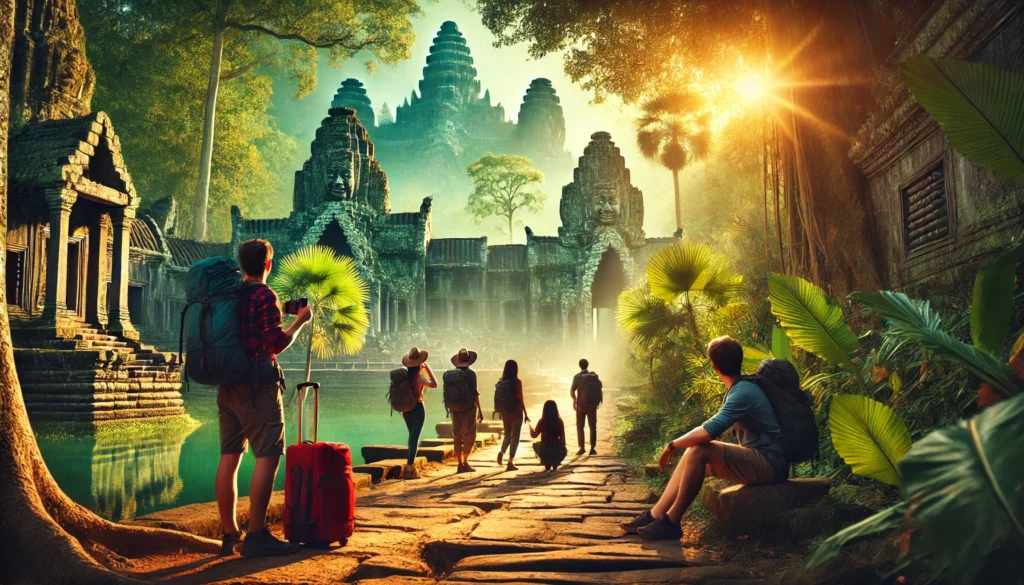Southeast Asia is a backpacker’s paradise, offering a perfect blend of rich culture, stunning landscapes, delicious cuisine, and affordable travel. From the bustling streets of Bangkok to the serene beaches of Bali, this region has something for every traveler. Whether you’re a seasoned backpacker or a first-time traveler, this comprehensive guide will help you navigate the vibrant and diverse countries of Southeast Asia.

Chapter 1: Planning Your Trip
1. Research and Itinerary
Before setting off on your adventure, spend some time researching the destinations you want to visit. Southeast Asia is vast, and each country offers unique experiences.
Top Destinations:
- Thailand: Known for its beautiful beaches, vibrant nightlife, and rich culture.
- Vietnam: Famous for its delicious food, historic sites, and stunning landscapes.
- Cambodia: Home to the majestic Angkor Wat and friendly locals.
- Laos: Offers serene landscapes and a slower pace of life.
- Indonesia: Features diverse islands, including Bali, known for its beaches and cultural attractions.
- Malaysia: A mix of modern cities and lush rainforests.
- Myanmar: Offers a glimpse into traditional Southeast Asian culture with its ancient temples and pagodas.
Creating an Itinerary:
- Plan your route based on the places you want to visit and the time you have.
- Consider the weather, as some countries have rainy seasons that can affect travel plans.
- Allow for flexibility in your schedule to accommodate spontaneous adventures and recommendations from fellow travelers.
2. Budgeting
One of the best things about backpacking in Southeast Asia is its affordability. However, it’s essential to budget wisely to make the most of your trip.
Average Daily Costs:
- Accommodation: $5-$20 for hostels, $20-$50 for budget hotels.
- Food: $1-$5 for street food, $5-$15 for restaurant meals.
- Transportation: $1-$3 for local transport, $5-$20 for long-distance buses or trains.
Tips for Budgeting:
- Use travel apps and websites to compare prices and find the best deals on accommodation and transport.
- Eat local food to save money and experience authentic flavors.
- Look for free or low-cost activities, such as hiking, visiting temples, and exploring local markets.
Chapter 2: Packing Essentials
3. Travel Gear
Packing light is crucial for a successful backpacking trip. Focus on essentials and versatile items.
Backpack: Choose a comfortable and durable backpack with a capacity of 40-60 liters. Clothing: Pack lightweight, breathable clothing suitable for warm climates. Include a rain jacket and a warm layer for cooler evenings. Footwear:Comfortable walking shoes, flip-flops, and a pair of sandals. Accessories: Sunglasses, hat, travel towel, reusable water bottle, and a power bank.
4. Travel Documents
Ensure you have all necessary travel documents and copies.
Passport: Valid for at least six months from your date of entry. Visas: Check visa requirements for each country and obtain necessary visas in advance. Travel Insurance: Essential for covering medical emergencies, trip cancellations, and lost belongings. Copies: Keep digital and physical copies of your passport, visas, travel insurance, and important contacts.
Chapter 3: Getting Around
5. Transportation
Southeast Asia offers various transportation options, making it easy to get around.
Flights: Budget airlines like AirAsia, Scoot, and Lion Air offer affordable flights between major cities and islands.Buses: Long-distance buses are a popular and economical way to travel between cities and countries. Trains: Train travel is available in countries like Thailand and Vietnam, offering scenic and comfortable journeys. Tuk-tuks and Motorbikes: Ideal for short distances and exploring cities. Always negotiate the fare before starting your ride.
6. Border Crossings
Many Southeast Asian countries share borders, making overland travel a common choice.
Land Borders: Research border crossing points and requirements in advance. Visas on Arrival: Some countries offer visas on arrival at land borders, but check the specific requirements. Transportation: Use reputable bus companies for international routes to ensure a smooth crossing.
Chapter 4: Accommodation
7. Hostels and Guesthouses
Hostels and guesthouses are the most popular accommodation options for backpackers.
Hostels: Offer dormitory-style rooms, social atmospheres, and communal facilities. Guesthouses: Provide private rooms, often with basic amenities and a more local feel.
Tips for Choosing Accommodation:
- Read reviews on booking platforms to find clean and safe options.
- Look for hostels with communal areas to meet other travelers.
- Check for included amenities like free Wi-Fi, breakfast, and lockers.
8. Unique Stays
Southeast Asia also offers unique accommodation experiences.
Homestays: Stay with local families to experience their culture and lifestyle. Eco-Lodges: Ideal for nature lovers, offering sustainable and environmentally friendly stays. Treehouses and Beach Bungalows: For a memorable and scenic experience.
Chapter 5: Cultural Experiences
9. Festivals and Events
Participating in local festivals and events is a great way to immerse yourself in the culture.
Songkran (Thailand): The Thai New Year celebrated with a massive water fight in April. Tet (Vietnam): The Vietnamese Lunar New Year, marked by family gatherings and festivities. Bon Om Touk (Cambodia): The Water Festival celebrating the end of the rainy season with boat races and fireworks.
10. Temples and Historical Sites
Southeast Asia is rich in history and spirituality, with numerous temples and historical sites to explore.
Angkor Wat (Cambodia): The largest religious monument in the world and a UNESCO World Heritage site. Bagan (Myanmar): An ancient city with thousands of temples and pagodas. Borobudur (Indonesia): A magnificent Buddhist temple complex and UNESCO World Heritage site.
Chapter 6: Culinary Delights
11. Street Food
Southeast Asia is famous for its street food, offering a variety of delicious and affordable dishes.
Pad Thai (Thailand): Stir-fried noodles with shrimp, tofu, and peanuts. Pho (Vietnam): A flavorful noodle soup with beef or chicken. Nasi Goreng (Indonesia): Fried rice with vegetables, meat, and a fried egg on top.
Tips for Enjoying Street Food:
- Look for busy stalls with high turnover to ensure freshness.
- Try local specialties and be open to new flavors.
- Stay hydrated and carry hand sanitizer.
12. Cooking Classes
Taking a cooking class is a fun way to learn about local cuisine and take home new skills.
Thailand: Learn to make dishes like green curry and mango sticky rice. Vietnam: Discover the secrets of fresh spring rolls and banh mi. Indonesia: Master the art of preparing satay and gado-gado.
Chapter 7: Adventure Activities
13. Hiking and Trekking
Southeast Asia offers stunning landscapes perfect for hiking and trekking.
Mount Rinjani (Indonesia): A challenging trek up an active volcano with breathtaking views. Chiang Mai (Thailand):Various trekking routes through lush jungles and hill tribe villages. Sapa (Vietnam): Scenic rice terraces and ethnic minority villages.
14. Water Sports
With its beautiful beaches and clear waters, Southeast Asia is ideal for water sports.
Scuba Diving: Explore vibrant coral reefs and marine life in Thailand, Indonesia, and the Philippines. Snorkeling: Enjoy snorkeling spots in Malaysia’s Perhentian Islands and Cambodia’s Koh Rong. Surfing: Catch waves in Bali, Indonesia, and Siargao, Philippines.
Chapter 8: Safety and Health
15. Staying Safe
Safety is a priority when traveling, and there are steps you can take to ensure a secure trip.
Stay Aware: Be aware of your surroundings and avoid risky areas, especially at night. Secure Belongings: Use a money belt or hidden pouch to carry valuables. Stay Connected: Keep in touch with family and friends and share your itinerary.
16. Health Tips
Maintaining good health is crucial for an enjoyable trip.
Vaccinations: Ensure you are up-to-date on recommended vaccinations. Stay Hydrated: Drink plenty of water and use bottled or filtered water. Food Safety: Eat at reputable places and avoid raw or undercooked foods.
Chapter 9: Making Connections
17. Meeting Fellow Travelers
Meeting other backpackers can enhance your travel experience and provide companionship.
Hostel Common Areas: Use common areas to meet people and join group activities. Travel Apps: Use apps like Meetup and Couchsurfing to find events and meetups. Social Media Groups: Join Facebook groups for backpackers in Southeast Asia.
18. Engaging with Locals
Connecting with locals can provide deeper insights into the culture and way of life.
Learn Basic Phrases: Knowing a few words in the local language can go a long way. Show Respect: Be respectful of local customs and traditions. Volunteer: Consider volunteering opportunities to give back to the community.
Conclusion
Backpacking through Southeast Asia is an incredible adventure filled with diverse cultures, stunning landscapes, and unforgettable experiences. By planning carefully, packing wisely, and staying open to new experiences, you can make the most of your journey. This guide provides the essential tips and insights you need to explore Southeast Asia with confidence and curiosity.
So grab your backpack, embrace the spirit of adventure, and get ready to create memories that will last a lifetime.
Happy travels!


